|
|
|
Ornithological Notes made at Chefoo (Province of Shantung, North China)
R. Swinhoe
Colour plate (Turdus chrysopleurus): J.G. Keulemans
Ibis: Volume 16, Issue 4, pages 422-447
1874
Opening lines: "I arrived at Chefoo on the 25th April, too late for the gamemarket, but in time to catch the inflow of the later migrant land-birds. Few English readers will probably know where Chefoo is; so it will be as well to say something of its position on the globe before proceeding to give my ornithological experiences there. The northward coast-line of China ends at the Shantung promontory; and the land now bearing westwards discovers at a distance of about sixty-eight miles the little harbour called Yentai by the Chinese, which was opened to foreign trade by the Treaty of Tientsin of 1860, as more accessible to shipping than the port of Tengchow city (named in the treaty), which is situate about forty miles further west on the coast, and within the Prefecture of which this locality is included."
|
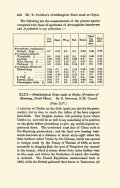
 |
|
On the Genus Todus
R. Bowdler Sharpe
Colour plate (Todus subulatus and Todus pilcherrimus): J.G. Keulemans
Ibis: Volume 16, Issue 4, pages 344-355
1874
Opening lines: "The discovery of an apparently new species of Todus is an event of some interest; and I am indebted to Mr. Henry Whitely, of Woolwich, for the specimen which first set me working on this genus. It is certainly the most beautiful species yet known, and apparently undescribed. The collection in which it came to England was said to have been sent direct from Jamaica; but, although the bulk of the birds were undoubtedly from that island, it may be doubted whether there is any corner so little explored as to produce a new Todus and the curious Phyllomanes iora, lately described by me from the same collection."
|

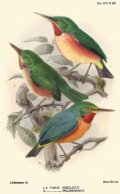 |
|
A Visit To The Principal Museums Of The United States, With Notes On Some Of The Birds Contained Therein
Osbert Salvin
2 colour plates (Granatellus francescae / Geotrygon veraguensis): J.G. Keulemans
Ibis: Volume 16, Issue 4, pages 305-329
1874
From the opening lines: "I spent less than five weeks visiting the chief towns in the eastern States, a time much too short to do more than examine hurriedly the contents of the chief museums, both public and private. Of course the Museum of the Smithsonian Institution in Washington occupied the largest share of my attention, though I employed much time in examining Mr. Lawrence’s extensive and interesting collection. I also paid several visits to the American Museum of Natural History in New York; and I spent an afternoon at Vassar College, a day at Philadelphia, half a day each with Dr. S. Cabot in Boston and Dr. T. K. Merritt in Flushing, several days in the Museum of the Boston Society of Natural History, and a morning at the Museum of Comparative Zoology at Harvard College. Everywhere I was treated with the utmost kindness and courtesy, and the freest access was given me to all the specimens I wished to examine."
|
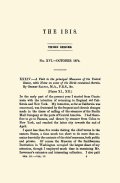
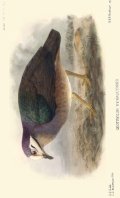 |
|
Notes on Chinese Ornithology
R. Swinhoe
Colour plate (Circus melanoleucus): J.G. Keulemans
Ibis: Volume 16, Issue 3, pages 266-270
1874
Opening lines: "In the last number of 'The Ibis' for 1873 was published a letter from myself at Shanghai, in which I stated that I had procured in the market a Circus cineraceus in immature plumage. On my return to England I reexamined this Hawk, and made it out to be, with Mr. R. B. Sharpe's aasistance, the immature of Circus melanoleucus and wrote to the Editor of 'The Ibis,' correcting my mistake (Ibis, 1873, p. 364). Mr. Gurney agrees in my present identification and with the Editor's kind permission Mr. Keuleman's excellent handiwork gives life to the description of the specimen I now transcribe from my notes."
|
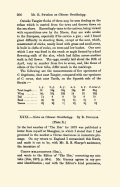
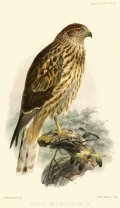 |
|
On Rare Or Little-Known Limicolae: The Genus Recurvirostra
James Edmund Harting
Colour plate (Recurvirostra andina): J.G. Keulemans
Ibis: Volume 16, Issue 3, pages 241-261
1874
Opening lines: "So long ago as 1863, in Wiegmann's 'Archiv' for that year, p. 131, Messrs. Philippi and Landbeck described an Avocet from the Andes, which they named Recurvirostra andina, and which was said to differ materially from the only species of the genus then known to inhabit the New World. Their description and measurements, to which I shall presently refer, left little to be desired save the acquisition of further specimens and the information which other observers might supply as to the geographical range and habits of the bird. Strange to say, although ten years have elapsed since it wm brought to the notice of ornithologists, no further observations, so far as I am aware, have been published in regard to this interesting species."
|
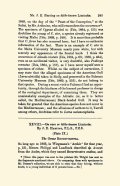
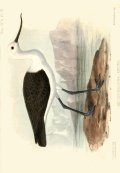 |
|
On the Neotropical Species of the Family Pteroptochidae
P.L. Sclater
Colour plate (Rhinocrypta fulva): J.G. Keulemans
Ibis: Volume 16, Issue 3, pages 189-206
1874
Opening lines: "In 1831 the zoological traveller Kittlitz established the genus Pteroptochus upon three new species of birds which he had observed in Chili in 1827, during his sojourn there with the expedition of the 'Seniavin.' He distinguished them principally by their remarkably short and rounded wings - never used in flight according to his observations, and their large feet and strong curved claws. He considered them allied to the Wrens (Troglodytes) and referred what is actually another member of the same group of birds (Triptorhynus paradoxus) which he discovered at the same time, to the genus Troglodytes."
|
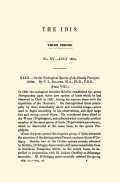
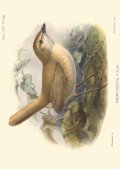 |
|
On some Birds from Hakodadi, in Northern Japan
R. Swinhoe
Colour plate (Chelidon blakistoni and Chelidon whitelyi): J.G. Keulemans
Ibis: Volume 16, Issue 2, pages 150-166
1874
Opening lines: "Mr. Thomas Blakiston, resident in Hakodadi, the port of Yesso, the most northern island of the Japanese group, with the help of a Japanese gentleman, Mr. Fnkusi Goro, in the service of the Japanese Government, has again been collecting the birds of Northern Japan, and has sent me a fine series, which I have carefully studied and compared, and will now enumerate, with remarks."
|

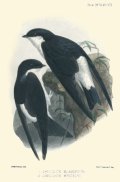 |
|
On A Further Collection Of Birds Made By Lieutenant Robert Wardlaw Ramsay, F.Z.S., In The Andaman Islands
Arthur Viscount Walden
3 colour plates (Ninox obscures / Ninox affinis / Dendrocitta baylei): J.G. Keulemans
Ibis: Volume 16, Issue 2, pages 127-149
1874
Opening lines: "Since publishing my notes on a collection of birds made in the Andamans by Lieutenant Wardlaw Ramsay, that gentleman has kindly sent to me a large number of specimens from the same locality, the fruits of about two months' indefatigable exertion. They include thirty-nine species additional to those contained in his first consignment. These I propose to notice in the following pages, while in a future number of 'The Ibis' I hope to be able to lay before its readers a complete list of the species known to inhabit the Andaman archipelago, together with some further remarks on some of the species mentioned in my former paper."
|

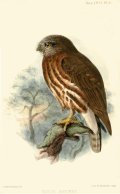 |
|
Additional List of and Notes on Birds Obtained in the Republic of Trans–Vaal
Thomas Ayres
Colour plate (Alauda conirostris and Megalphonus erythrochlamys): J.G. Keulemans
Ibis: Volume 16, Issue 2, pages 101-107
1874
This is a continuation of a paper from an earlier issue.
Opening lines: "Petrochelidon spilodera (Sund.) Prince Alfred's Swallow. Two colonies of these birds now visit us regularly at Potchefstroom every year, appearing in August. One takes possession
of the Dutch church, building under the eaves; this colony consists of about twenty pairs. The other has taken up its quarters under the eaves of the Dopper, or dissenting Dutch church, at the other end of the town, and, I think, is rather more numerous than the first."
|
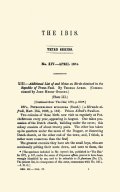
 |
|
Notes On The Ornithology Of The Gold Coast
Herbert Taylor Ussher
Colour plate (Picathartes gymnocephalus): J.G. Keulemans
Ibis: Volume 16, Issue 1, pages 43-75
1874
Opening lines: "The following rough notes have been put together at the request of my friend Mr. Sharpe, who has described in this Journal the collections made by me during my residence in Fantee. I am induced to offer them to the readers of 'The Ibis' as a supplement to his papers; and as so little is known respecting the economy of West-African birds, I trust they may not be devoid of interest. The nomenclature employed is that of Mr. Sharpe's papers in this Journal, or of his catalogue of African birds, Dr. Hartlaub's well-known work being quoted where the birds are not referred to in the above-mentioned lists."
|
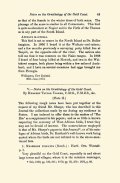
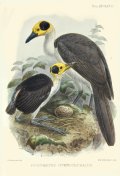 |
|
On the Prionochili of British India
P.L. Sclater
Colour plate (Prionochilus vincens and Prionochilus melanoxanthus): J.G. Keulemans
Ibis: Volume 16, Issue 1, pages 1-3
1874
Opening lines: "The genus Prionochilus was established, in 1841, by the late Mr. Strickland for the reception of the birds described and figured in the 'Planches Coloriees' of Temminck, as Pardalotus percussus (Pl. Col. 894. fig. 2), Pardalotus thoracicus (Pl. Col. 600. figs. 1 & 2), and Parddotus maculatus. Mr. Strickland considered the affinities of this group to be with Calyptomena, which it approaches in the structure of the beak and feet much more nearly than to Pardalotus."
|

 |
|
Notes on Birds observed at Para
E.L. Layard
With Descriptions of Two New Species by P.L. Sclater
2 colour plate (Picolaptes layardi / Thamnophilus simplex): J.G. Keulemans
Ibis: Volume 15, Issue 4, pages 374-396
1873
Opening lines: "The collection on which these notes are founded was got together chiefly in my early morning walks, from sunrise to 9 o’clock or a little later. It was commenced at the end of June 1872, and therefore only includes such birds m I could get during the dry season; this terminates in December. Last year our rains began about the 15th January, and up to the date on which I write (January 28th) have bcen pretty continuous. Some tine days have certainly intervened ; and then the temperature has been lovely, and the early mornings in the forest inexpressibly delightful. Now, however, the early mornings break with the sun behind clouds, and the forest is wet and heavy with mist, while underfoot it is mire up to one's ankles. Of course in case of the least brush through the bushes in search of a wounded bird, you are drenched from head to foot."
|
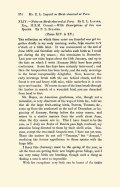
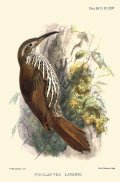 |
|
Note on the Fulica alba of White
Osbert Salvin
Colour plate (Aegialitis varius / Aegialitis sanctae-helenae): J.G. Keulemans
Ibis: Volume 15, Issue 3, pages 295
1873
Opening lines: "In a former number of 'The Ibis' for the current year (antea, p. 45)) I referred to a Plate which I was having prepared from a coloured drawing, sent to me by Herr von Pelzeln, of the typical specimen of the Fulica alba of White. This plate (Plate X.) is now given herewith. On comparing the coloured drawing with the specimens of Notornis mantelli in the British Museum, it appeared evident that the bird in the Imperial Cabinet at Vienna must belong to Notornis. The short wings and the short toes, as well as the outline of the beak, indicated clearly a far greater generic affinity with Notornis than with Porphyrio."
|

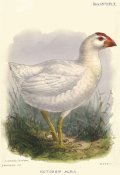 |
|
On Rare Or Little-Known Limicolae
James Edmund Harting
2 colour plate (Aegialitis varius / Aegialitis sanctae-helenae): J.G. Keulemans
Ibis: Volume 15, Issue 3, pages 260-269
1873
Opening lines: "It frequently happens that a general description of form and colour intended to indicate a particular species applies 80 well to another for which it was not intended, that unless measurements are added, or some marked specific character pointed out, it is impossible to discriminate the two without reference to the type or types which furnished the description. A case in point is afforded by the Charadrius pecuarius of Temminck."
|
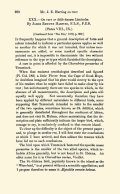
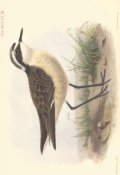 |
|
On the Genus Platystira and its Allies
R. Bowdler Sharpe
Colour plate (Diaphorophia blissetti and Platystira peltata): J.G. Keulemans
Ibis: Volume 15, Issue 2, pages 156-177
1873
Opening lines: "By all students of African ornithology the genus Platystira is admitted to be full of perplexities; and any attempt at a monographic revision of it must be a step in the right direction. I have taken some pains to examine large series of these birds, contained principally in the national and my own collections; and by rejecting all statements which seem to be at all open to doubt, I trust that I shall be able to place the genus on a satisfactory footing, and so assist future research. Any record rejected by me as untrustworthy at the present time will easily be reinstated afterwards, if found to be correct; or, on the other hand, my verdict will be confirmed by subsequent observation."
|
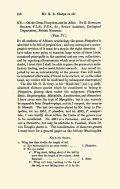
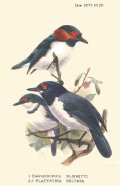 |
|
On A New Species Of Little Bittern From China
Robert Swinhoe
Colour plate (Ardetta eurythma): J.G. Keulemans
Ibis: Volume 15, Issue 1, pages 73-74
1873
Opening lines: "The Ardetta figured by v. Schrenk (Reisen im Amurlande, Vogel, t. xiii.) as the young of Ardetta cinnamomea has long been a puzzle to me. A. cinnamomea is a very common summer bird in the south of China, and, knowing it in every phase of plumage, I found it impossible to associate with it v. Schrenk's bird. What, then, could the Amoorland bird be? for no species could cross to the north of China without occurring in China itself. The doubtful bird was not A. Sinensis; with that also I was well acquainted. I could not settle the question; and it passed out of my mind until the other day, when a bird, identical with v. Schrenk's figure was brought to me - a beautiful bird, with its back all starred with white."
|
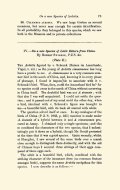
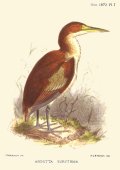 |
|
On The Birds In The Collection At Vienna Obtained From The Leverian Museum
A. Von Pelzeln
Colour plate (Trichoglossus pygmaeus): J.G. Keulemans
Ibis: Volume 15, Issue 1, pages 14-54
1873
Opening lines: "It was in the year 1806 that the celebrated museum formerly in possession of Sir Ashton Lever and then of Mr. T. Parkinson, was sold by auction in London. Rich as this collection was, its value was further increased by the circumstance that the types of a number of species described by various authors were therein included. The reigning Emperor of Austria, Francis I., resolved, on the report of Director von Schreibers, that some of the treasures of this collection should be acquired for the Imperial Museum at Vienna; and the well known naturalist Leopold von Fichtel, being about to proceed to England, was commissioned with the negotiation of the purchase. In fulfilling his mission Herr von Fichtel bought at the auction no less than 82 mammals, more than 200 birds, 60 reptiles, 73 fishes, and other objects of various classes of the animal kingdom. Among the birds there were included a considerable number of types, especially of species described or figured by Latham in his 'General Synopsis of Birds' and 'Index Ornithologicus,' by White in the 'Journal of a Voyage to New South Wales,' and by Shaw in the 'Museum Leverianum'."
|
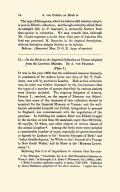
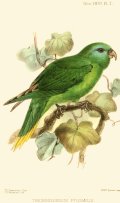 |
|
On a Collection of Birds recently made by Mr. A. H. Everett in Northern Borneo
Arthus Viscount Walden
Colour plate (Setornis criniger): J.G. Keulemans
Ibis: Volume 14, Issue 4, pages 360-383
1872
Opening lines: "Having lately had an opportunity of examining a small collection of birds obtained in Northern Borneo by Mr. A. H. Everett, it has occurred to me that a list of the species it included might form an acceptable addition to our knowledge of the avifauna of that island. Hitherto the Bornean collections sent to London by Mr. Everett have been dispersed before being catalogued, and the valuable materials he had contributed to the formation of a complete list of North-Bornean birds were thus rendered unavailable. This is the more to be regretted, as most of his Specimens have labels attached which give the origin and sex of each example, and other useful information. These notes, whenever they occur, are here introduced within inverted commas."
|

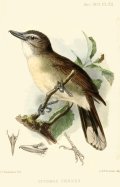 |
|
On a New Parrakeet of the genus Loriculus from the Philippine Islands
P.L. Sclater
Colour plate (Loriculus chrysonotus): J.G. Keulemans
Ibis: Volume 14, Issue 3, pages 323-344
1872
Opening lines: "In April 1871 the Zoological Society of London obtained by purchase, of a dealer in Liverpool, a pair of Parrakeets of the genus Loriculus, said to have been brought from the Philippine Islands. These I determined as Loriculus culacissi, that being the species in Dr. Finsch’s excellent Monograph with which they appeared to agree most nearly. Along with these birds the Society also obtained a specimen of Tanygnathus luconensis, the Philippine representative of these large-billed Parrots, which was likewise new to the Society's collection."
|
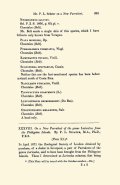
 |
|
A Revision of the Genus Henicurus
H.J. Elwes
Colour plate (Henicurus frontalis): J.G. Keulemans
Ibis: Volume 14, Issue 3, pages 250-262
1872
Opening lines: "Though the genus Henicurus does not present any grave difficulties to the ornithologist, yet, as the species composing it have been a good deal confused and from what we know of its geographical distribution it is not likely that any new ones remain to be discovered, I think the following notes may not be unacceptable."
|
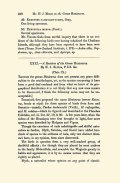
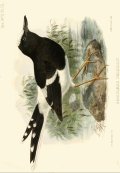 |
|
A Further Revision of the Genus Leucopternis, with a Description of a new Species
Osbert Salvin
Colour plate (Leucopternis plumbea): J.G. Keulemans
Ibis: Volume 14, Issue 3, pages 239-243
1872
Opening lines: "In August 1868 Mr. Sclater and I published a synopsis of the species of the genus Leucopternis, in the text accompanying a plate representing Leucopternis semiplumbea in 'Exotic Ornithology.' The genus, as then understood by us, contained eight species, which we divided into two categories - one, comprising seven species, having the whole of the underparts white, and the other, a single species, having those parts banded with white and leadcoloured bars. The species which I now propose to describe carries with it the bird usually known as Umbitinga schistacea (Sundev.); and the two together form a third section of the genus, having the whole of the underparts uniformly plumbeous in colour. My remarks on these two species, and a further note on L. princeps, form the principal subject-matter of this paper. For all further details respecting the other members of the genus reference must be made to the summary at page 121 of 'Exotic 0rnithology'."
|

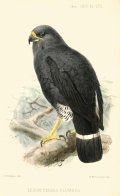 |
|
Supplementary Notes to 'The Birds of India'
T.C. Jerdon
Colour plate (Turdus dissimulis): J.G. Keulemans
Ibis: Volume 14, Issue 2, pages 114-139
1872
This is a continuation of a paper published in an earlier issue.
Opening lines: "LANIUS LAHTORA. This Shrike is now known to extend to Eastern Africa, L. pallens of Cassin, and L. dealbatus, De Fil., being considered synonyms."
|

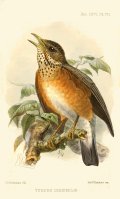 |
|
On Birds Recently Observed Or Obtained In The Island Of Negros, Philippines
Arthur Viscount Walden and Edgar Leopold Layard
3 colour plates (Chrysocolaptes xanthocephalus / Dicuris mirabilis / Ianthoenas oriseocularis): J.G. Keulemans
Ibis: Volume 14, Issue 2, pages 93-107
1872
Opening lines: "The Philippine Islands supplied the materials for the earliest memoir on exotic birds that has come down to us, written by the Moravian Jesuit, Camel, in 1703 (Phil. Trans. vol. xxiii.). From examples collected in the Philippine archipelago by Poivre and by Sonnerat, descriptions of many of the oldest species in our books were taken. Still, even at the present time, our knowledge of Philippine ornithology continues to be of the most elementary character, only 193 species being noted (v. Martens, J. fur 0. 1866) as known to inhabit the large and diversified area contained within the limits of the archipelago - an area which occupies an estimated surface of 110,000 square miles of dry land."
|
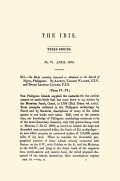
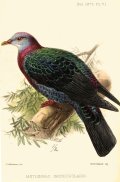 |
|
A Revision of the Species of the Fringilline Genus Sycalis
P.L. Sclater
2 colour plates (Sycalis chrysops and Sycalis lutea / Sycalis aureiventris): J.G. Keulemans
Ibis: Volume 14, Issue 1, pages 39-48
1872
Opening lines: "In 'The Ibis' for January last, I attempted to give some account of the present state of our knowledge of the species of the Fringilline genus Spermophila. I now propose to offer to the readers of this Journal some similar remarks on the members of the genus Sycalis, another characteristic type of the Neotropical Fringillidse, of which I have of late years accumulated a considerable series of specimens. My collection of this genus consists of 40 skins, referable to 8 species. I have likewise employed for comparison 18 specimens belonging to the collection of. Messrs. Salvin and Godman, and referable to 6 species, and have examined the specimens in the French National Collection, where several important types are to be found."
|
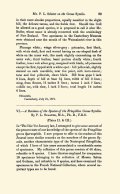
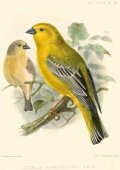 |
|
Supplementary Notes to 'The Birds of India'
T.C. Jerdon
Colour plate (Polyphasia passerina): J.G. Keulemans
Ibis: Volume 14, Issue 1, pages 1-22
1872
This is a continuation of a paper published in an earlier issue.
|
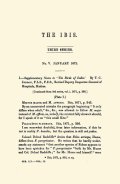
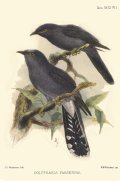 |
|
On Seven New Or Lately Described Species Of African Birds
R.B. Sharpe
Colour plate (Scotopelia ussheri): J.G. Keulemans
Ibis: Volume 13, Issue 4, pages 414-417
1871
Opening lines: "Having lately received some considerable collections of birds from Africa, I hasten to describe some of the new species contained in them. At the same time I take the present opportunity of giving an illustration of the new Scotopelia described in an earlier number of this Journal."
|
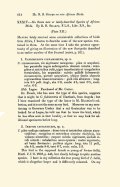
 |
|
Description of a new Genus and Species of Bird belonging to the Family Fringillidae
D.G. Elliot
Colour plate (Dolospingus nuchalis): J.G. Keulemans
Ibis: Volume 13, Issue 4, pages 402-403
1871
Opening lines: "The singular Finch here described was received by Madame Verdey, of Paris, in a small collection obtained on the Orinoco river, on the borders of British Guiana. In its general coloration and in the markings of its plumage it is not unlike the members of the genus Spermophila, and, were it not for its extraordinary bill, would seem to find its place most naturally in that genus. But the bill precludes such a disposition of this species; and indeed there is no genus known to me under which it may be classified; I have therefore proposed the term Dolospingus for this curious form. The type specimen was the only one sent, and now belongs to the Museum of Natural History of New York, for whose fine collection I have secured it."
|
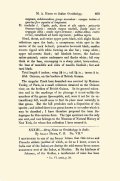
 |
|
Supplementary Notes to 'The Birds of India'
T.C. Jerdon
Colour plate (Cypselus infumatus): J.G. Keulemans
Ibis: Volume 13, Issue 3, pages 335-356
1871
This is a continuation of a paper published in an earlier issue.
Opening lines: "Spilornis bacha, Daudin. The Lesser Crested Serpent Eagle. It appears fully agreed on by all that the small Serpent-Eagle of Ceylon and Southern India is the same as the Andaman bird. It is common in the forests of Malabar; but as far south as the Deccan, at all events, is replaced by the large race. I well remember how the first specimen of S. cheela that I shot, near Doulatabad, surprised me much by its great size, compared with those I had previously seen in Malabar. It appears that S. cheela, stated by Tytler also to occur in the Andamans, has not been sent from that locality, as stated by Beavan, but corrected by Mr. Gurney; and Layard's statement of S. cheela occurring in Ceylon is also doubted by the same excellent authority."
|
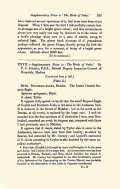
 |
|
Additional Notes on Birds of the Territory of the Trans-Vaal Republic
Thomas Ayres and John Henry Gurney
Colour plate (Ardea rufiventris): J.G. Keulemans
Ibis: Volume 13, Issue 3, pages 253-270
1871
This is a continuation of a paper published in an earlier issue.
Opening lines: "Philetaerus Socius (Lath.) Social Qrossbeak. I first met with this curious bird near the Vaal river, where there were several colonies amongst the large Camel-thorn trees. Their huge nests were very conspicuous at a considerable distance; I first saw them in July, 1869 (midwinter), when the birds, in flocks of from thirty to forty, were still inhabiting their nests, in which they appear to sleep all the year round, adding to them each summer as the colony increases. I visited a nest early one morning and found it apparently deserted j but on throwing a stone or two at it, I heard a gentle chattering, and presently out flew a bird, and then another, and another, till the whole family were out. I found them afterwards feeding on the ground at some little distance; on rising they uttered the same chattering note, and continued it during their flight."
|
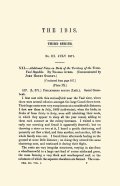
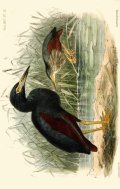 |
|
Observations of Dr. Stoliczka's "Contributions to Malayan Qrnithology"
Arthur Viscount Walden
Colour plate (Criniger gularis and Criniger phaeocephalus): J.G. Keulemans
Ibis: Volume 13, Issue 2, pages 158-177
1871
Opening lines: "By the publication of the paper the title of which is given above, Dr. Stoliczka has materially increased our knowledge of the ornithology of a region hitherto but little known. The small British possession of Province Wellesley appears never to have been before explored by the ornithologist, unless some portion of the so-called Pinang collections, which occasionally come to Europe, are made on the mainland. From this district Dr. Stoliczka enumerates about eighty-six species, chiefly belonging to the Picarie and Passeres. And it is perhaps the principal merit of these contributions that while they enable us, for the first time, to fix the northern limits of some, they extend our acquaintance with the range of many Malaccan species. Thanks to Dr. Stoliczka, our knowledge of the habitat of many Malayan species can no longer be summed up in the unsatisfactory and stereotyped words Malacca, or Singapore. In most instances copious notes are added, generally consisting of elaborate descriptions, objections to the validity of certain species, and rectifications in accordance with the author 's views of the synonymy of others."
|

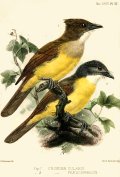 |
|
On the Psittacidae of Central America
Osbert Salvin
Colour plate (Conurus Finschi): J.G. Keulemans
Ibis: Volume 13, Issue 1, pages 86-100
1871
Opening lines: "Having recently received, in a collection from Veragua, two Parrots, one of which is apparently quite new to science, and the other new to the fauna of Central America, I take the opportunity of shortly reviewing such members of the family Psittacidae as are found between the Isthmus of Darien and the northern confines of the South-Mexican avifauna."
|

 |
|
On the Ornithology of Algeria
J.H. Gurney
Colour plate (Parus ledoucii): J.G. Keulemans
Ibis: Volume 13, Issue 1, pages 68-86
1871
Opening lines: "On the 25th of January, 1870, I disembarked at Oran, the chief town of the western province of Algeria, and a few days afterwards moved on in a coasting-steamer to Algiers. Before setting out for the Sahara, I devoted a month to collecting in the Tell, principally in the vicinity of Blida and Miliana; and it was not until the 1st of March that I finally started for the interior. The first caravanserai, properly so called, is Bougzout; the second is Ain-Oussera; the third, Guelt el Stel. The water at all these places is barely drinkable. On the 22nd of March I arrived at Laghouat, the last French outpost, the first oasis of the Sahara, a picturesque spot by reason of its tall Palms. To the northward stretch plains as far as Djelpha. Rocky mountain-ridges protect this oasis from the wind, which frequently blows the sand in overwhelming clouds."
|
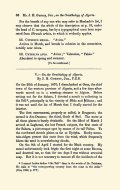
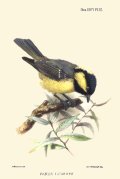 |
|
A Revision of the Species of the Fringilline Genus Spermophila
P.L. Sclater
2 colour plates (Spermophila nicrorufa and Spermophila pileata / Spermophila aurita and Spermophila ocellata): J.G. Keulemans
Ibis: Volume 13, Issue 1, pages 1-23
1871
Opening lines: "Up to the present time the best, and, indeed, it may be said the only authority worth referring to on the American Finches of the genus Spermophila has been Bonaparte's 'Conspectus Generum Avium.' In that well-known work this and the allied genera of Fringillidae are treated of with unusual accuracy, and short but, in most cases, sufficient diagnoses are added to the synonyms of the different species. In my 'Catalogue of Arnerican Birds' I have relied mainly upon Bonaparte's arrangement of the genus Spermophila, merely altering the order to a certain extent, and including among the true Spermophilae the species which Bonaparte has placed in the second division of his genus Sporophila."
|

 |
|
On A New Muscicapine Bird From Madagascar
R.B. Sharpe
Colour plate (Drymoeca brachyptera and Pytelia Schleceli): J.G. Keulemans
Ibis: Volume 12, Issue 4, pages 498-499
1870
Opening lines: "A small collection of birds recently brought from Madagascar by Mr. A. Crossley contains a single specimen of what appears to be the type of an entirely new genus, belonging to the family Mucscicapidae, which I propose to call Pseudobias."
|

 |
|
On Additional Collections of Birds from the Fantee Country
R.B. Sharpe
Colour plate (Drymoeca brachyptera and Pytelia Schleceli): J.G. Keulemans
Ibis: Volume 12, Issue 4, pages 470-488
1870
Opening lines: "Since the appearance of my last paper on the Ornithology of Fantee (supra, pp. 52-59), I have been so fortunate as to receive for description no less than five collections from this locality; and it will readily be believed that an examination of so large a series of birds has led to the discovery of many new and interesting facts."
|
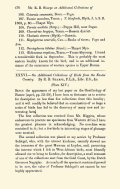
 |
|
Remarks On Some Lately-Described Pittae, With A Synopsis Of The Family As Now Known
Mr D.G. Elliot
2 colour plates (Brachyurus megarhynchus / Brachyurus oreas and Brachyurus bankanus): J.G. Keulemans
Ibis: Volume 12, Issue 3, pages 408-421
1870
Opening lines: "Since my monograph of the Pittidae was brought to a conclusion, now over seven years ago, several members of the family have been described as new; and it has occurred to me that a critical review of these, as regards their specific value, together with a comparison between them and those species long known to us, to which many of them bear a very close resemblance, might not be unacceptable to ornithologists. I am much indebted to Mr. Gould, Mr. Swinhoe, and Dr. Schlegel, who have allowed me the use of the types of their species for description in this paper, without which I should not have been able to make the examinations necessary, and arrive at satisfactory conclusions. The species described as new may be enumerated as follows: Pitta oreas, Swinhoe; P. megarhyncha, P. bankana, and P. sanghirana, Schleg.; P. simillima, P. strenua, Gould; P. krefti and P. bertae, Salvadori; and P. digylesi, Kreft. These 1 sball examine in detail."
|

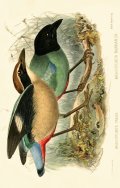 |
|
On Rare Or Little-Known Limicolae (Continued)
James Edmund Harting
Color plate (Agialitis geoffroyi): J.G. Keulemans
Ibis: Volume 12, Issue 3, pages 378-392
1870
Opening lines: "I proposed in my last paper, for the sake of convenience, to divide the rufous-breasted Plovers into two groups-those which in structure and habits resemble the Dotterels (Eudrornias), and those whose affinities are with the Shore-Plovers (Byialitis). Having disposed of the former, I now proceed with the latter, and will try to bring together materials for a complete history, so far as possible, of the remaining two species, Ae. geoffroyi and Ae. mongolicus, whose general resemblance, as I before mentioned, both in summer and winter plumage, has led to their being frequently confounded."
|

 |
|
On the Ornithology of Hainan
Robert Swinhoe
Color plate (Herphoris Tyrannulus): J.G. Keulemans
Ibis: Volume 12, Issue 3, pages 342-367
1870
This is the third part of a three part paper. The first part was published in Volume 12, Issue 1, pages 77-97. The second part was published in Volume 12, Issue 2, pages 230-256.
|

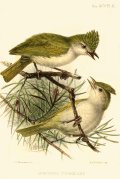 |
|
On the Ornithology of Hainan
Robert Swinhoe
Color plate (Hemixus castanonotus and Hypsipetes perniger): J.G. Keulemans
Ibis: Volume 12, Issue 2, pages 230-256
1870
This is the second part of a three part paper. The first part was published in Volume 12, Issue 1, pages 77-97. The third part was published in Volume 12, Issue 3, pages 342–367.
|

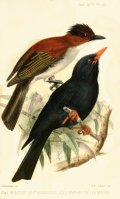 |
|
On the Oriolidse of the Ethiopian Region
R.B. Sharpe
2 color plate (Oriolus nigripennis and Oriolus notatus / Oriolus brachyrhynchus and Oriolus baruffii): J.G. Keulemans
Ibis: Volume 12, Issue 2, pages 213-229
1870
Opening lines: "The following sketch of the Orioles of Africa has been suggested to me during a recent study of the species in my collection; and as my series is extensive, I trust I may be able to throw some light upon the synonymy of the different species, some of which are involved in considerable obscurity. Mr. Gray 's 'Hand-list of Birds' indicates ten species of African Oriolidae as having been distinguished by modern authors. This is very nearly correct; but he has omitted Oriolus crassirostris, Hartl., apparently a very good species, and he has included 0. moloxita, Rupp., as distinct from 0. monacha (Gmel.), to which I think it may be undoubtedly referred."
|
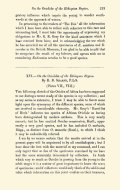
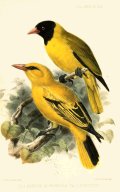 |
|
On Rare Or Little-Known Limicolae
James Edmund Harting
2 color plate (Eudromias asiaticus / Eudromias veredus): J.G. Keulemans
Ibis: Volume 12, Issue 2, pages 201-213
1870
Opening lines: "An attempt to identify the Charadrius asiaticus of Pallas, necessitates the examination of a very beautiful group of Plovers. The peculiarity which, for the present purpose, connects the different species of this group, is the assumption during the breeding-season of a bright rufons band across the breast. I say for the present purpose, because, as will be seen hereafter, the species which, on account of this peculiarity, are here brought together belong to two different genera - the one an inland genus, Eudromias, the other a littoral one, Aegialitis."
|
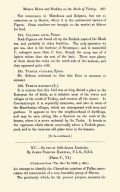
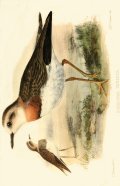 |
|
On the Ornithology of Hainan
Robert Swinhoe
Color plate (Megalaema faber and Megalaema nuchalis): J.G. Keulemans
Ibis: Volume 12, Issue 1, pages 77-97
1870
This is the first part of a three part paper. The second part was published in Volume 12, Issue 2, pages 230-256. The third part was published in Volume 12, Issue 3, pages 342–367.
Opening lines: "After my successful researches in the island of Formosa, I was determined, should an opportunity offer itself, to pay a visit to the island of Hainan. The opportunity came in the spring of 1868, when Her Majesty's Minister at Peking, being desirous to obtain information on the commercial capabilities of that island, with a view to opening a port in it for European trade, gave me instructions to repair thither in a gunboat to prosecute inquiries, the whole cruise not to extend over two months and a half. Apart from the investigations on behalf of the Government, I gained the Minister's permission to devote my leisure time during the trip to the study of the natural productions of the new country."
|
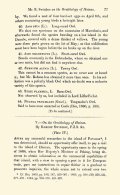
 |
|
On a Fourth Collection of Birds from the Fantee Country
R.B. Sharpe
2 color plates (Cassinia rubicunda and Cassinia finschi / Astur macrurus): J.G. Keulemans
Ibis: Volume 12, Issue 1, pages 52-59
1870
Opening lines: "This collection was received by Mr. Higgins in July 1869, and was immediately handed over to me for determination. Though scarcely so rich in species as the last, it nevertheless contains many interesting birds, several of which are recorded from the Fantee Country for the first time; and these are, as in my former lists, distinguished by having a dagger prefixed to their names."
|
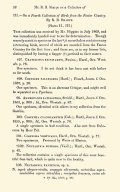
 |
|
On the Sun-birds of the Indian and Australian Regions
Arthur Viscount Walden
Color plate (Aethopyga christinae and Nectarophila grayi): J.G. Keulemans
Ibis: Volume 12, Issue 1, pages 18-51
1870
Opening lines: "All those Sun-birds which are not found in the Ethiopian region form the subject-matter of this paper. The geographical range of the group extends, on the mainland of Asia, from the mouth of the Indus, in the west, to the shores of the Chinese Sea in the east. It includes, besides Ceylon, nearly all, if not all, the islands of the Indo-Malayan and Austro-Malayan subregions."
|

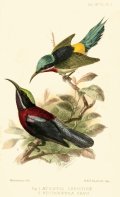 |
|